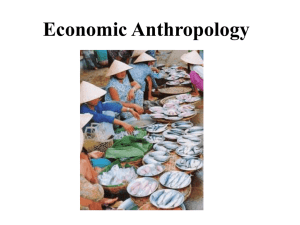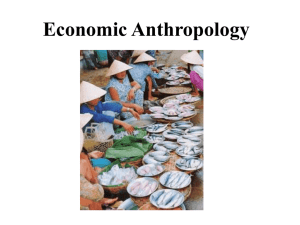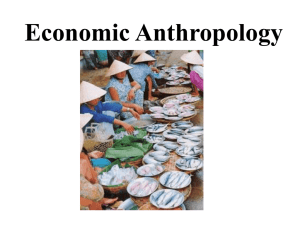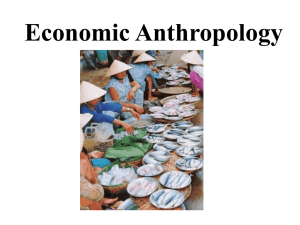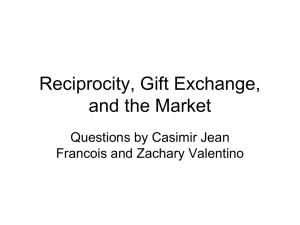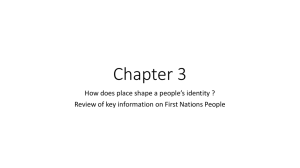Economic Anthropology
advertisement
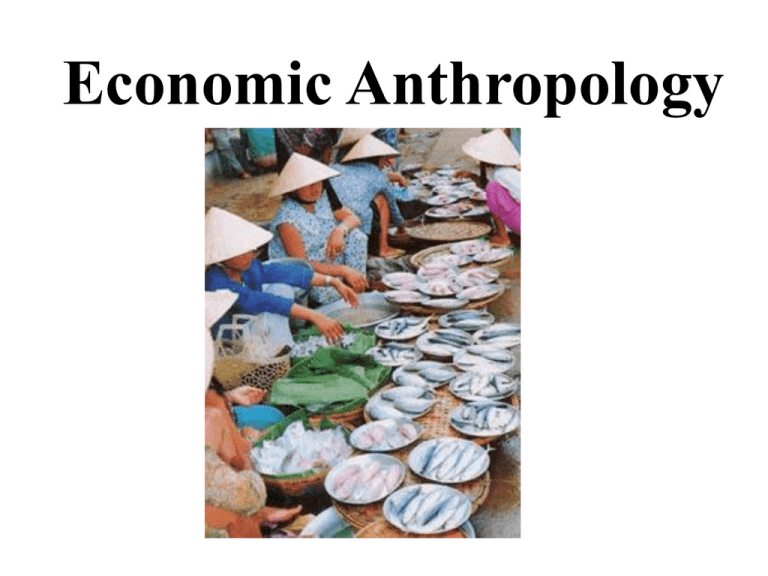
Economic Anthropology What is Economic Anthropology? “At the most basic, economic anthropology is the description and analysis of economic life, using an anthropological perspective” (Carrier 2005:1) Tomato seller on African market Ghanaian Market Economic Word economics comes from Greek word Oikonomikos Oikos means house Root nem, means to regulate, administer, and organize A society’s economy consists of: 1. Production 2. Distribution/ Exchange 3. Consumption Economics is the study of production, distribution, exchange, and consumption of resources. Economic Life the activities through which people produce, circulate and consume things Why did the average price for a house in Calgary skyrocket in 2006? Economizing and Maximization Classic economic theory assumes 1. That the value or price of a commodity increases as demand goes up and decreases as supply goes up. 2. That as prices go up sellers enter the market and bring the price down 3. That as prices go down sellers leave the market to bring prices up 4. That eventually equilibrium is reached 5. that individuals act rationally, by economizing to maximize their utility (i.e. profits or satisfaction) Comparative data show that people frequently respond to other motivations than profit The Trobrianders produce far more yams than they can ever eat. Some they give to their sister’s husband and others they simply allow them to rot. Why? economic anthropologists tend to situate productive activities and forms of exchange and consumption, in larger social and cultural frames, in order to see how they affect and are affected by other areas of life. In some societies artistic styles are the property of certain kinship groups. Only members of the kin group are allowed to produce them. Exchange “The act of giving or taking one thing in return for another” “The transfer of things between social actors” What kinds of things are exchanged? the communicative exchange of language (culture) the exchange of goods the exchange of spouses. Exchange is a key to social life Exchange is important for the establishment and maintenance of social relationships Patterns of exchange and circulation, lead us to the heart of social and cultural organization WHO exchange relationships WHAT what is the significance and meaning of what is exchanged WHERE what is the significance and meaning of where it is exchanged WHEN on what occasions WHY social reasons HOW ceremony, mechanisms WHAT IS A GIFT? What kinds of gifts are there? Who do we give gifts to? When do we give gifts? How do we give gifts? Why do we give gifts? Botticelli 1486 Giovanna degli Albizzi Receiving a Gift of Flowers from Venus IS THERE ANY SUCH THING AS A FREE GIFT? What are the consequences of not reciprocating? Are there bonds of obligation? Is there some competitiveness involved in gift giving? How do we feel when we haven’t received a gift of at least equal value? What if the gift returned is of higher value? “If Friends make gifts, Gifts Make Friends” Marcel Mauss Marcel Mauss 1925: The Gift: The Form and Reason for Exchange in Archaic Societies Mauss points to three fields of obligation: to give, to receive and to repay Gifts, according to Mauss, create relationships not only between individuals but between groups, relationships which take the form of “total prestations” 1872 - 1950 The principle of Reciprocity The notion of a pure gift is simply ideology, in reality no one does anything for nothing An equivalent return is expected Society is created by, and its cohesion results from, an endless sequence of exchanges in which everyone pursues their own advantage, however that advantage is conceived The donor may gain prestige and power by transforming the recipient into a debtor The creation of unequal relationship until a return gift is made maintains the relationship Obligations are kept because both sides benefit from giving and receiving gifts the costs of reneging are too great in terms of self-interest, ambition and vanity, and sometimes supernatural sanctions For Mauss it is not individuals but groups or moral persons who carry out exchanges The persons who enter into exchanges do so as incumbents of status positions and do not act on their own behalf The gift also contains some part of the spiritual essence of the donor and this constrains the recipient to make a return Most commentators on Mauss (e.g. Shalins, Firth, Levi-Strauss) see the idea of reciprocity a form of social contract as correct And not the Maori notion of the Hau as a general explanation for reciprocity The Potlatch A form of ceremonial exchange of gifts employed by indigenous groups on NW coast of BC (Tlingit, Haida, Tsimshian and Kwakiutl (Kwakwaka'wakw)) Described at length by Franz Boas in 1897 in The Social Organisation and the Secret Societies of the Kwakiutl Indians Aboriginally, The Kwakwaka'wakw (Kwakiutl), were very rich and their fishing grounds supplied them with considerable surplus E.S. Curtis, 1915 Beginning of summer they dispersed to go hunting, gather roots and berries, fish for salmon in the rivers At the onset of winter they concentrated in small villages During this period social life became extremely intense "Interior of Habitation at Nootka Sound" John Webber (British), April 1778 The Kwakiutl house is constructed of cedar boards on a framework of heavy logs. The ridge extends from front to back, the roof-boards run from ridge to eave, and the wall boards are perpendicular. POTLATCH: The word means ‘to give’ held in connection with events in the life cycle, initiations, marriages, house building, funerals, assumption of certain dance privileges. extravagant and lavish preparations including much food preparation and the creation of masks and art work are made by the host as gifts for the guests Announcing a Potlatch, On a ceremonial dugout canoe, made from a single cedar log, costumed bird and animal dancers announce a potlatch (Lazare and Parker/National Wildlife Federation). Whole clans and villages were invited to the potlatch Potlatch Guests Arriving at Sitka, Winter 1803 Bill Holm © 1997 “Indian visitors arriving at Potlatch at Kok-woi-too Village Chilkat River, Alaska” 1895 Potlatches included speeches, singing, dancing, feasting, and giftgiving. Serving food and Kwakwaka'wakw Winter Dance This dance is being performed at a southern Kwakwaka'wakw village on Quatsino Sound. Elaborate theatrical performances were an important part of Northwest Coast native life (watercolour by Gordon J. Miller) distributing gifts allowed the host to demonstrate his generosity and wealth and to assert his ancestral privileges to the guests. Masks and headdresses worn during dances depicted the supernatural being who had "given" the dance to the host or one of his ancestors. Button blankets were worn during dances and given as gifts. 19th Century Kwakiutl Button Blanket Kwakiutl Potlatch Mask Before contact, gifts might have included canoes, slaves, goat hair blankets, and food The variety and quantities of gifts increased with European trade. Every article used in ceremony and as well many utilitarian objects such as storage boxes were carved and decorated. ceremonial objects included masks, headdresses, shawls, rattles, aprons, copper shields and painted boards. Each of these embodied the crests of the owner and proclaimed clan associations, ownership, family history, rights, and privileges. Their beauty, the painstaking effort taken in their manufacture, and the high cost of the materials used, determined only a small part of their value the true value of these objects lies in their symbolism The most central symbol of wealth, power and prestige was the copper a shield-shaped plate of beaten copper that usually with a painted or engraved representation of a crest animal of their original owners on its surface. During Potlatch ceremonies, the host would sometimes break the copper and distribute it to high status guests. Copper gifting sometimes would involve rivalry. If a chief offered a broken piece of his copper to a rival, the rival had to return the favour with a piece of copper or equal or greater value or suffer humiliation. Broken copper Tsimshian: Gitsan, British Columbia Collected by G.T. Emmons, prior to 1914 Chilkat Blanket" 1890-1900, Tlingit The Kwakiutl chief Tulthidi prepares to give away his valuable copper in honor of his son It was the Chief's responsibility to ensure that all members of his lineage were adequately provided for. Within the lineage, rank was judged in descending order according to one's relationship to the Chief Potlatches became very competitive aspiring leaders used competitive potlatching to move up the system. The potlatch is a system of gift exchange-- material goods are exchanged for social recognition and power Tlingit Chiefs, dressed in full regalia, gathered at a Potlatch ceremony in Sitka in 1904. Because of all the gifts, a traditional potlatch took years to prepare A large potlatch held in 1921 was said to take 17 years of preparation A modern day potlatch may take about a year to prepare and cost $10,000. C. 1900 Today potlatch gifts include coffee mugs, socks, hand knit blankets and clothes, as well as carved masks and murals Potlatches commemorate a significant event in an extended family's or clan's collective life. They are held today for baby Twined grass basket showers, namings, weddings, Nootka/Makah, British Columbia/Washington anniversaries, special birthdays, graduations, and as memorials for the dead Cedar carrying basket with handles Why would they spend years accumulating wealth only to give it away - or even throw the objects into the sea? Potlatch at Fort Rupert, British Columbia, 1898 Social Significance potlatch celebrations are a significant representation of the host's status and the display of rank and title In return for giving away food and wealth they get recognition of their status and that of their lineage. Marriages for one’s children and places in the brotherhoods are only won during the potlatch Potlatches become very competitive aspiring leaders use competitive potlatching to move up the system. The potlatch is a system of gift exchange--- material goods are exchanged for social recognition and power the aim is to crush the opponent chief with excessive obligations that cannot be repaid Potlatch Regalia Dance regalia given up by Kwakiutl who attended Dan Cranmer's potlatch in 1921 at the village of Alert Bay, NWT (Royal British Columbia Museum). The federal government outlawed potlatches in 1884 but the ceremony continued in many communities in 1951 the law was deleted from the revised Indian Act The obligation to give The obligation to receive The obligation to reciprocate Prestation Also includes reciprocity and the various obligations ‘total social phenomenon’ It is not individuals but collectives that impose obligations of exchange and contract upon each other What is exchanged is not solely property and wealth What rule of legality and self-interest, in societies of a backward or archaic type, compels the gift that has been received to be obligatorily reciprocated? What power resides in the object given that causes its recipient to pay it back?” (Mauss 1925) To Mauss the gift was animated with the spiritual essence of its original donor (Mauri hau) to whom it strives to return. This constrains the recipient to make a return When one gives something away one is also giving part of oneself -- an object imbued with one’s own personality/spirit and which therefore puts one literally in the hands of one’s creditor To receive something is to receive part of the essence of the giver Because of this the indebted is constrained to make a return Failure to return a gift can result in serious trouble including the death of the recipient The bonds created by gifts are thus mutually dependent ties between persons Kwakiutl Potlatch Mask Thomas and Jane Carlyle’s Christmas Presents Renowned 19th century English historian and essayist Spent Christmas in the 1850s with Lord and Lady Ashburton (wealthy Scottish banker) Thomas and Jane Carlyle Lord and Lady Ashburton •In 1851 The Ashburton’s gave Christmas presents to the Carlyles • Mrs Carlyle got a scarf and a bracelet • Thomas got a jigsaw puzzle • both were well received In 1855 Mrs Carlyle received a black silk dress - A novelty because it was only recently that they were produced by machine Mrs Carlyle claimed that she was being insulted. What do we have to know to be able to understand those meanings attributed to these gifts? class social mobility matrimony patronage employment manufacturing processes issues of style conventions of gift-giving Gift Exchange operates not according to market laws, but the social rules of power, symbol, convention, etiquette, ritual, role and status. Exchange (at least gift giving) is embedded in social life Raffia Cloth among the Lele (Zaire) The movement of raffia cloth among the Lele is another example of the mediation of status by goods. Younger men need raffia (as bridewealth) to marry. But raffia is made and controlled by older men. In order to have access to raffia and hence marriage, younger men need the social approval of older men. Since more raffia is required to marry than any one man can produce, it takes community approval to marry. In modern economy, men can gain access to raffia through wage labor. This undercuts authority of elders and leads to charges of the selling of brides. Economic Anthropology: Substantivist Formalists -economic affairs are embedded in social institutions and cannot be studied separately from other social institutions social structures •kinship system •political structure •religious ideologies -people in nonindustrial economies function with different logic than capitalist economies. Exchanges occur for reasons other than economic benefit • culturally unique values • group benefits • “rational” culturally relative • prestige • maximize personal gain •supply-demand relationships • “rational” decision-making • individual self interest •economy can be analyzed independent of other social structures and institutions •research tools of western economics applicable Karl Polanyi Divided economies into three types according to the dominant mode of distribution reciprocity-- The return of a gift or prestation redistribution -- collection from members of a group and then redistribution within this group. E.g. tribute, taxes market --involves money and profit 1886-1964 Marshal Sahlins Stone Age Economics (1972) A material transaction is usually a momentary episode in a continuous social relation. The social relation governs the nature of the immediate exchange and the flow of goods Sahlins suggests that there are 3 types of reciprocity that form a continuum that correlates with kinship and social distance. 1930- Reciprocity: exchange between social equals 1. Generalized 2. Balanced 3. Negative Generalized reciprocity e.g. gifts, or sharing, helping, generosity. between close kin and friends highly moral – no expectation of return In some societies e.g. Ju/’hoansi, it ensures survival, an equitable sharing of food, and maintains social bonds between families Generalized reciprocity is correlated with Rank relative wealth and need food Geographic distance Balanced reciprocity return expected delayed exchange maintains ties with more distant people A precise balance between the things exchanged Important in e.g. peace making death payments and marriage alliances. Kula Ring – Balanced Reciprocity Kula Ring: vast inter-island system of exchange of certain classes of ritual objects — men’s armbands and bracelets not a system of “commercial trade” in utilitarian objects (most islands self-sufficient in staple foods & goods) objects acquired, displayed, and then passed on mwali soulava Like the crown jewels, their value is symbolic There is no practical utility Each valuable has its own name and history Owning them provides the owner with prestige and pride Vaygu’a – Kula Valuables assessed for their value based on size, colour, and how well they are polished or finished shells increase in value with age and both men and shells gain prestige in their association with one another man may gain fame and notoriety for having possessed a particularly fine armband similarly, a necklace may be highly regarded for having been owned by a great man Temporary ownership allowed men to draw a great deal of renown, to exhibit the article to tell how it is obtained and to plan on whom he is going to give it This history and renown was the main source of their value Main principle underlying regulations of exchange is that of bestowing a ceremonial gift, which has to be repaid by an equivalent counter-gift after a lapse of time, be it a few hours or years A form of credit. – implies a high degree of trust and commercial honour One transaction does not finish the kula relationship Once in the Kula always in the Kula Lifetime partnerships Once in the Kula always in the Kula also applies to valuables Some of the named kula valuables mentioned by Malinowski are still circulating at each meeting, “visiting” partner bestows gift on home partner the same object that he received from his other partner a few months or years earlier over time, value (rarity) of objects exchanged increases, as does renown of the partners necklaces A B C D A B C D armbands Kula Ring had been cited as an example of the economic irrationality of “savages”… –took great risks for “fanciful” ends –not survival or commerce, but to obtain “baubles” –pursued out of “sheer habit” the Kula Ring is a vital institution which contributes to the security and continuity of Massim cultures –needs to be seen within the total context of Massim society –ripped out of context, it appears irrational, “savage” How does the kula differ from classic economic ideas? Exchange is not done freely – hereditary partners Only two items Not based on need since the aim is to exchange articles that serve no utilitarian purpose No price mechanism Value not determined by supply and demand Never ends Highly ritualized Based on obligations Delayed exchange Surrounded by mythology what makes the Kula an economic exchange? Negative Reciprocity less common impersonal, distrustful not based on ongoing social relations exchange without money taking items by force Haggling at the market of Riobamba, Ecuador Reciprocity: Generalized Balanced value unspecified return not immediate long term view no gratitude expected Equal value Expectation of immediate return Similar to trade or barter Creating AND satisfying obligations Common in more distant kin relationships Negative Personal gain is primary motivator something for nothing - haggling - bargaining - theft /seizure - cheating Self Interest Prevalence in band societies intertribal tribe village lineage family social distance determines the nature of the exchange Compare exchanges with children and parents versus aunts and uncles with nieces and nephews Other relatives versus strangers Redistribution Exchange among social unequals centralized accumulation and reallocation of wealth (taxes, tributes, tithes, spoils) –maintain power, superior status (internally) –keep constituents happy, maintain standard of living –use wealth to leverage power (externally) –leveling mechanisms typical mode of exchange in chiefdoms and some nonindustrial states These workers in Yunnan Province, China, strive for an equal distribution of meat. Redistribution in Western Society Taxes Food Bank Collected taxes redistributed in services and welfare to those in need Redistribution based on moral norms and cultural values about social justice and equal opportunity Modern market exchange refers to vice-versa movements between hands in a market system requires a system of price making markets in order for integration the dominant mode of integration in modern industrial societies Kumasi's Central Market, Kumasi, Ghana Market exchange value preset by impersonal “market forces” exchange occurs presumably independent of and uninfluenced by social relations usually involves money, a widely agreed on abstract symbol used to measure value Kawelka Moka 1. What motivates someone like Ongka to work so hard? 2. What functions does a moka serve? 3. What are the gender roles involved in putting on a moka 4. Is the moka outdated?
